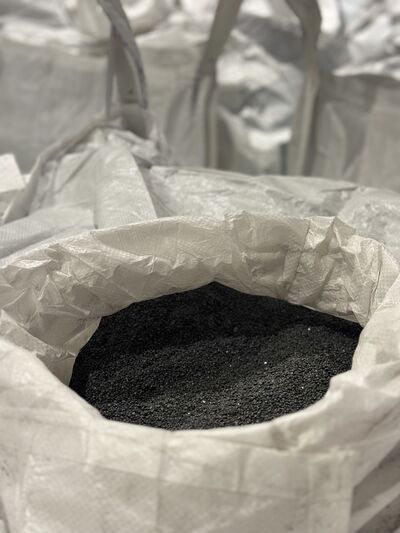Recycled Plastic in Construction : GreenMantra's Domenic Di Mondo: "We transform waste plastics into high-performance specialty polymers and additives"

The roofing industry generates approximately 13 million tons of asphalt shingle waste annually. How does this contribute to the broader waste problem in construction and infrastructure?
The roofing industry plays a role in construction and infrastructure waste. However, roofing is already one of the most recycled building materials, and the industry continues to advance sustainable solutions. Efforts to divert shingle waste from landfills through recycling help reduce the environmental footprint of construction while also repurposing valuable materials for new roofing products and infrastructure applications, such as roads and pavement.
Advances in polymer-modified asphalt and roofing formulations are further proving that recycled materials can enhance durability, flexibility, and longevity. As demand for sustainable infrastructure grows, contractors, specifiers, and manufacturers are leading the way in adopting and refining circular solutions.
By integrating more recycled content into asphalt mixes and developing innovative ways to reuse shingle waste, the industry is not only addressing its own waste stream but also contributing to broader circular economy efforts in construction.
By integrating more recycled content into asphalt mixes and developing innovative ways to reuse shingle waste, the industry is not only addressing its own waste stream but also contributing to broader circular economy efforts in construction.Domenic Di Mondo, GreenMantra
What are the main barriers preventing sustainable waste management in both the roofing and paving industries?
Roofing and paving are already among the most recycled building materials, with both industries continuously advancing sustainability efforts. Investments in recycling technologies are making it even easier to process asphalt shingles, bitumen-based products, and reclaimed asphalt pavement efficiently.
Continued investment in recycling infrastructure, supportive policies, and collaboration across the value chain will further enhance both industries' ability to reduce waste and maximize material recovery, reinforcing roofing's role as a leader in sustainable building practices.
What sort of plastics are used in GreenMantra’s processes?
Currently, GreenMantra’s molecular recycling technology utilizes polypropylene and polyethylene recycled materials from across North America—streams of waste plastic that are typically more difficult to recycle by traditional mechanical recycling, like various types of packaging materials.
How does GreenMantra’s molecular recycling process work, and how does it differ from traditional recycling approaches?
GreenMantra’s molecular recycling process transforms waste plastics into high-performance specialty polymers and additives. Unlike traditional mechanical recycling, which melts and reshapes plastic, our process breaks down plastic at a molecular level into new, functional materials. By repurposing waste plastics into performance-enhancing additives, GreenMantra is helping industries reduce reliance on virgin materials, improve product durability, and support a more circular and sustainable future for roofing, paving, and other industrial applications.
What role do CERANOVUS polymer additives play in making both roofing materials and asphalt roads more sustainable?
CERANOVUS makes it easier for manufacturers to add recycled materials into their product designs. By enabling the use of recycled materials in roofing and paving applications, CERANOVUS additives support a more circular economy, helping to divert plastic waste from landfills while enhancing the performance and longevity of essential infrastructure.

What benefits do these additives provide in terms of durability, flexibility, and overall performance?
CERANOVUS polymer additives enhance durability, flexibility, and overall performance in both roofing and asphalt applications.
In roofing materials, these additives improve asphalt shingles by increasing resistance to weathering, and mechanical stress at elevated temperatures, helping extend their lifespan and reducing maintenance needs.
CERANOVUS additives improve asphalt performance by enhancing rutting resistance, ensuring durability under heavy traffic loads and high temperatures. As a warm mix additive, they allow asphalt to be produced and laid at lower temperatures, reducing emissions while maintaining workability. They also help minimize tracking during road maintenance, making paving processes cleaner and more efficient. By improving adhesion and enabling greater use of recycled materials, CERANOVUS additives contribute to longer-lasting roads, lower repair costs, and a more sustainable infrastructure.
Road construction companies and municipalities are increasingly open to using recycled materials, particularly recycled asphalt pavement (RAP) and recycled asphalt shingles (RAS), due to cost savings, environmental benefits, and proven durability.Domenic Di Mondo, GreenMantra
Are asphalt shingles produced with these additives considered recyclable?
Asphalt shingles produced with CERANOVUS additives remain fully recyclable. These additives enhance shingle performance without compromising their ability to be processed through existing shingle recycling programs. By improving durability and flexibility, they help extend the lifespan of shingles while still allowing for material recovery at the end of their use. This supports a more circular approach in the roofing industry, enabling the repurposing of recycled shingles into new roofing products or asphalt paving applications.
There can be skepticism around using recycled materials in industries that prioritize longevity and safety. How has the roofing and paving industry responded to these innovations?
The roofing and paving industries prioritize durability and safety so integrating recycled materials requires rigorous testing and validation. In response to innovation, both industries have embraced advanced formulations and technologies that enhance material properties while incorporating recycled content.In paving, recycled asphalt pavement (RAP) and recycled asphalt shingles (RAS) are widely used, with DOT regulations ensuring performance comparable to virgin materials. Studies confirm that RAP and RAS improve road durability while lowering costs. The Federal Highway Administration supports these practices, which reinforces their viability. The roofing industry is increasingly embracing recycled materials as sustainability becomes a greater priority. Shingle manufacturers are innovating with recycled rubber and plastics in roofing membranes and shingles, with extensive testing helping to validate long-term performance. Green building incentives and growing industry confidence are further accelerating adoption. As advancements continue, the use of recycled materials in both roofing and paving is expected to expand, supporting a more sustainable future without compromising durability or safety.
What kind of testing and certifications have been conducted to ensure the performance of asphalt shingles and roads using GreenMantra’s additives?
GreenMantra’s additives have undergone extensive laboratory testing and field trials to ensure they meet the highest performance standards for asphalt shingles and roads.
In roofing, asphalt shingles containing CERANOVUS additives have been tested for durability, flexibility, adhesion, and weather resistance, ensuring they meet industry benchmarks. Testing aligns with ASTM standards and manufacturer specifications to confirm that the additives enhance shingle properties without compromising recyclability or quality.
In paving, CERANOVUS additives have been assessed using AASHTO and ASTM testing protocols to ensure they enhance road durability while enabling greater use of recycled materials. These rigorous evaluations, along with successful field trials and industry partnerships, continue to demonstrate that GreenMantra’s additives deliver sustainable solutions without compromising performance in paving applications.

Are road construction companies and municipalities open to using recycled materials, or is there still hesitation in the market?
Road construction companies and municipalities are increasingly open to using recycled materials, particularly recycled asphalt pavement (RAP) and recycled asphalt shingles (RAS), due to cost savings, environmental benefits, and proven durability.
Many state DOTs and the FHWA support their use, with some states setting minimum RAP content requirements. However, hesitation remains in certain areas due to concerns about material variability, performance in extreme conditions, and additional processing requirements. While larger firms have widely adopted recycled materials, smaller companies and municipalities with limited recycling infrastructure may be slower to implement them. As sustainability goals, regulatory incentives, and improved recycling technologies continue to drive adoption, skepticism is gradually diminishing, but full-scale acceptance depends on continued research and standardization.
Scaling up recycled materials in roofing and paving faces hurdles like material consistency, as variations in recycled asphalt, shingles, and plastics can impact durability.Domenic Di Mondo, GreenMantra
What are the biggest hurdles in scaling up the use of recycled materials in roofing and paving?
Scaling up recycled materials in roofing and paving faces hurdles like material consistency, as variations in recycled asphalt, shingles, and plastics can impact durability. Regulatory challenges also slow adoption, with inconsistent policies across states favoring virgin materials. Limited recycling infrastructure makes processing and transporting recycled materials costly in some regions. Industry skepticism persists as contractors prioritize reliability and may be reluctant to use materials without a long-established performance record. While sustainability goals and cost savings drive progress, overcoming these barriers requires improved processing, standardized regulations, and proven performance data.
How can manufacturers, regulators, and industry stakeholders collaborate to make construction materials more sustainable?
Collaboration among manufacturers, regulators, and industry stakeholders is key to driving sustainability in construction materials. Manufacturers can invest in innovation and testing to develop high-performance materials incorporating recycled content while maintaining durability and safety standards. Regulators can support adoption by establishing clear guidelines, incentives, and certifications that encourage sustainable practices without adding unnecessary barriers. Industry stakeholders, including contractors and specifiers, can advocate for and adopt proven sustainable solutions, ensuring demand for greener materials continues to grow.
By working together, the industry can expand recycling infrastructure, standardize material specifications, and drive policy changes that support circular economy practices.

Looking ahead, do you envision a future where most asphalt-based products—both shingles and roads—are made with a significant percentage of recycled content?
Yes, the future of asphalt-based products is moving toward incorporating a significant percentage of recycled content. Both the roofing and paving industries have made great strides in using recycled materials, and as technology advances, adoption is expected to grow even further.
In paving, the widespread use of reclaimed asphalt pavement (RAP) and performance-enhancing additives like CERANOVUS is already proving that high-recycled-content roads can meet or exceed traditional performance standards. Similarly, in roofing, manufacturers are increasingly adopting polymer-modified shingles and asphalt formulations that integrate recycled plastics and rubber while maintaining durability and weather resistance.
With continued innovation, supportive regulations, and growing industry confidence, the shift toward circular solutions will accelerate. As sustainability becomes a core priority, the industry is well-positioned to make high-recycled-content asphalt products the norm rather than the exception.


